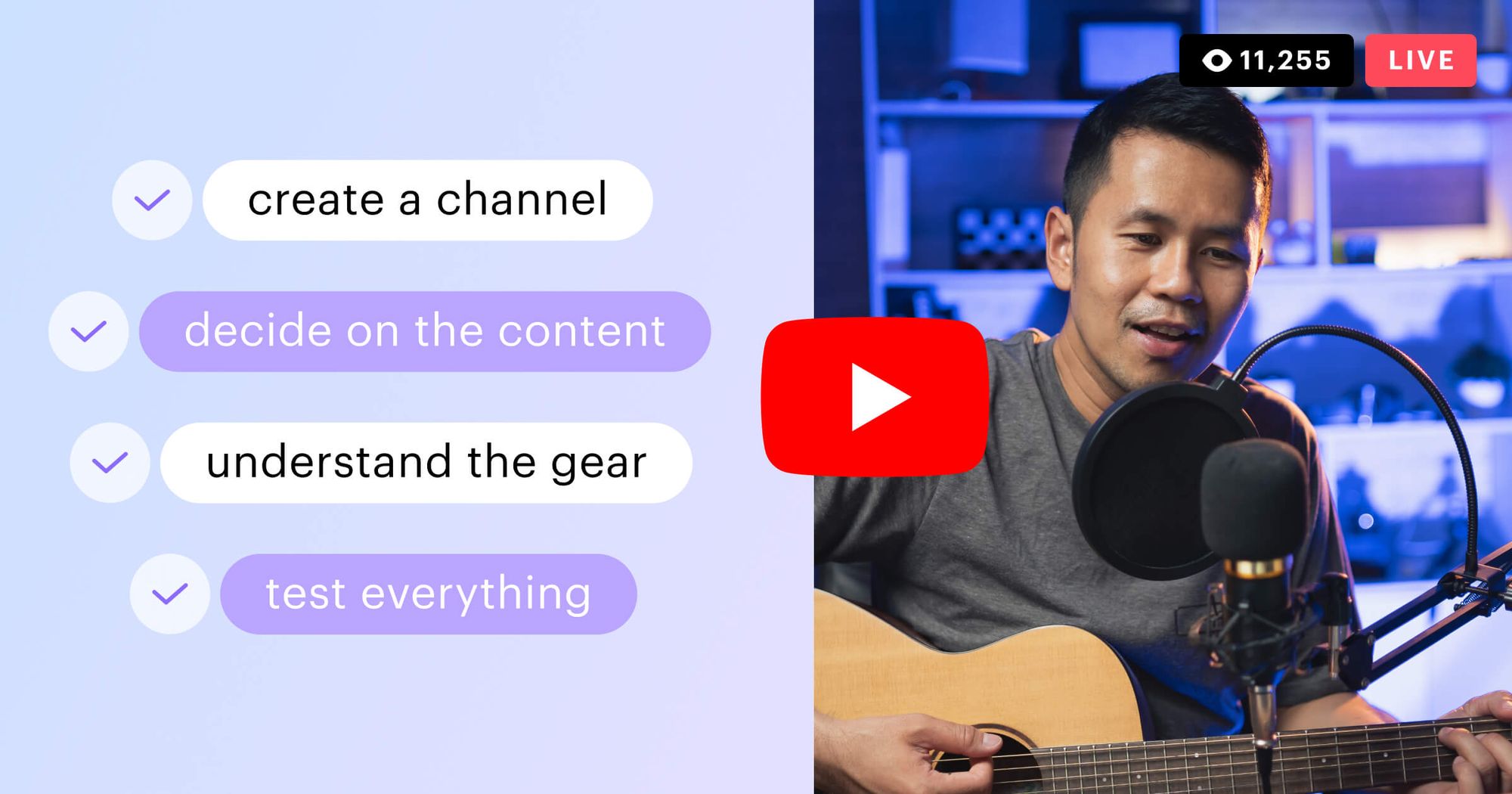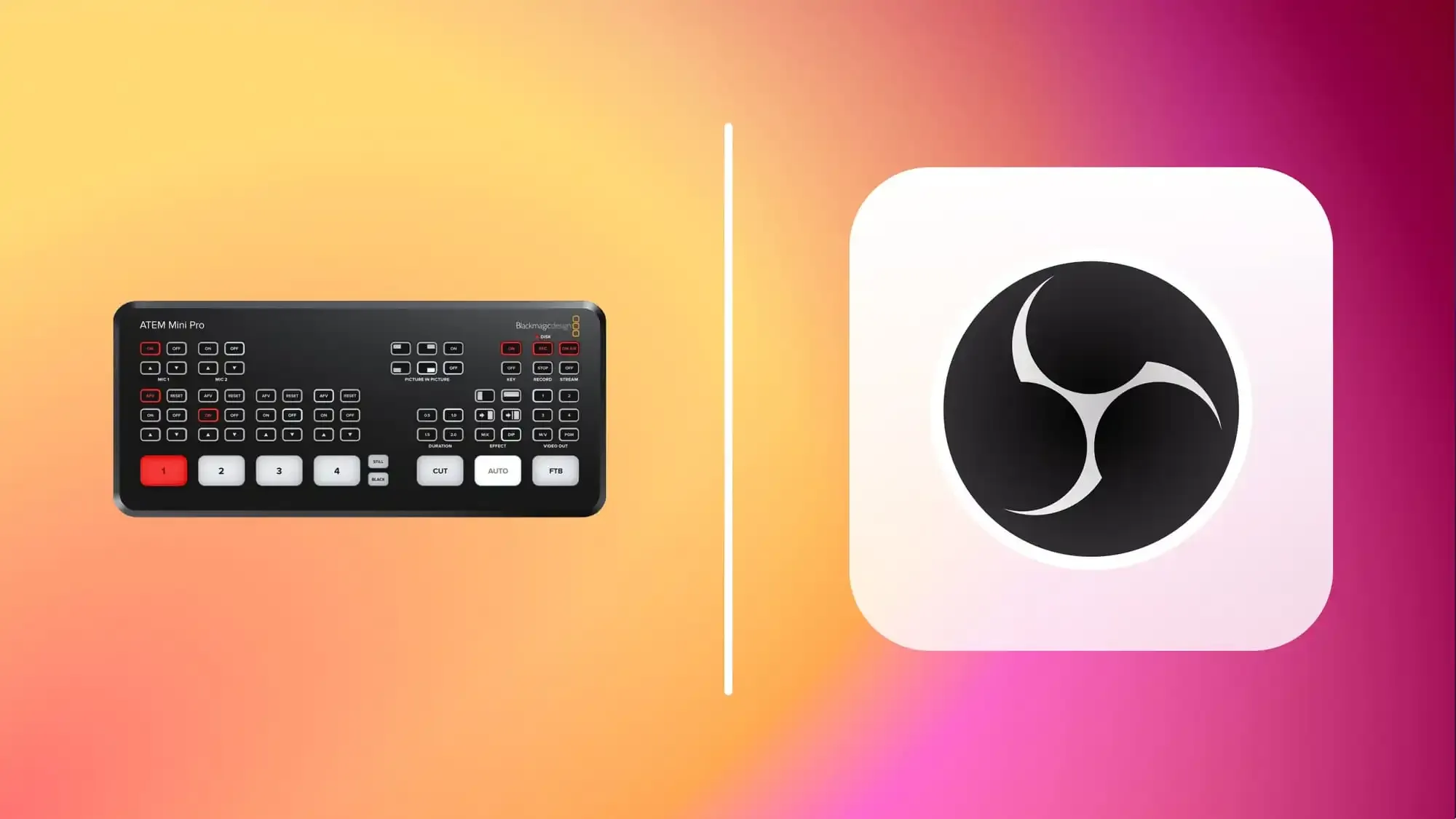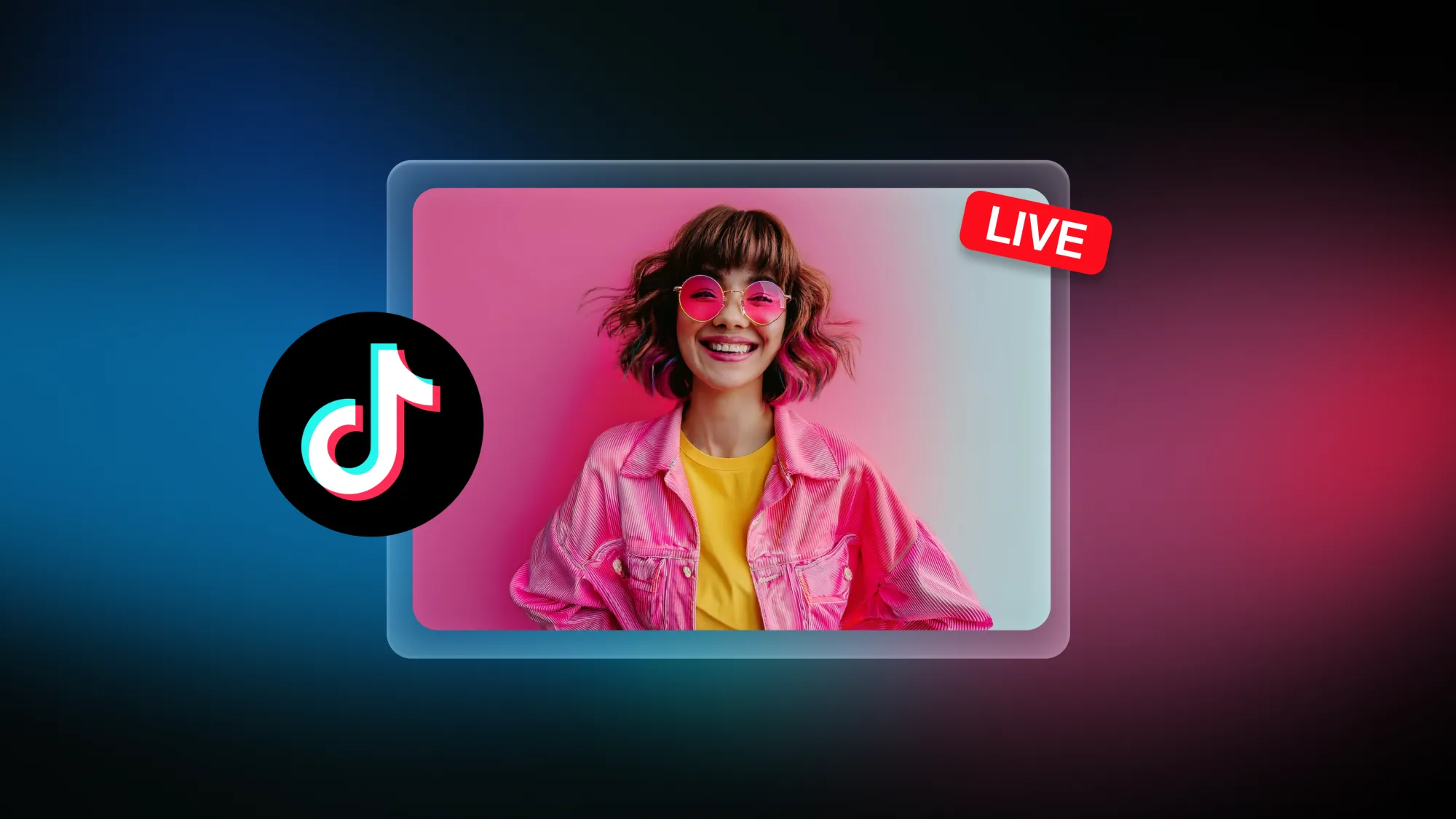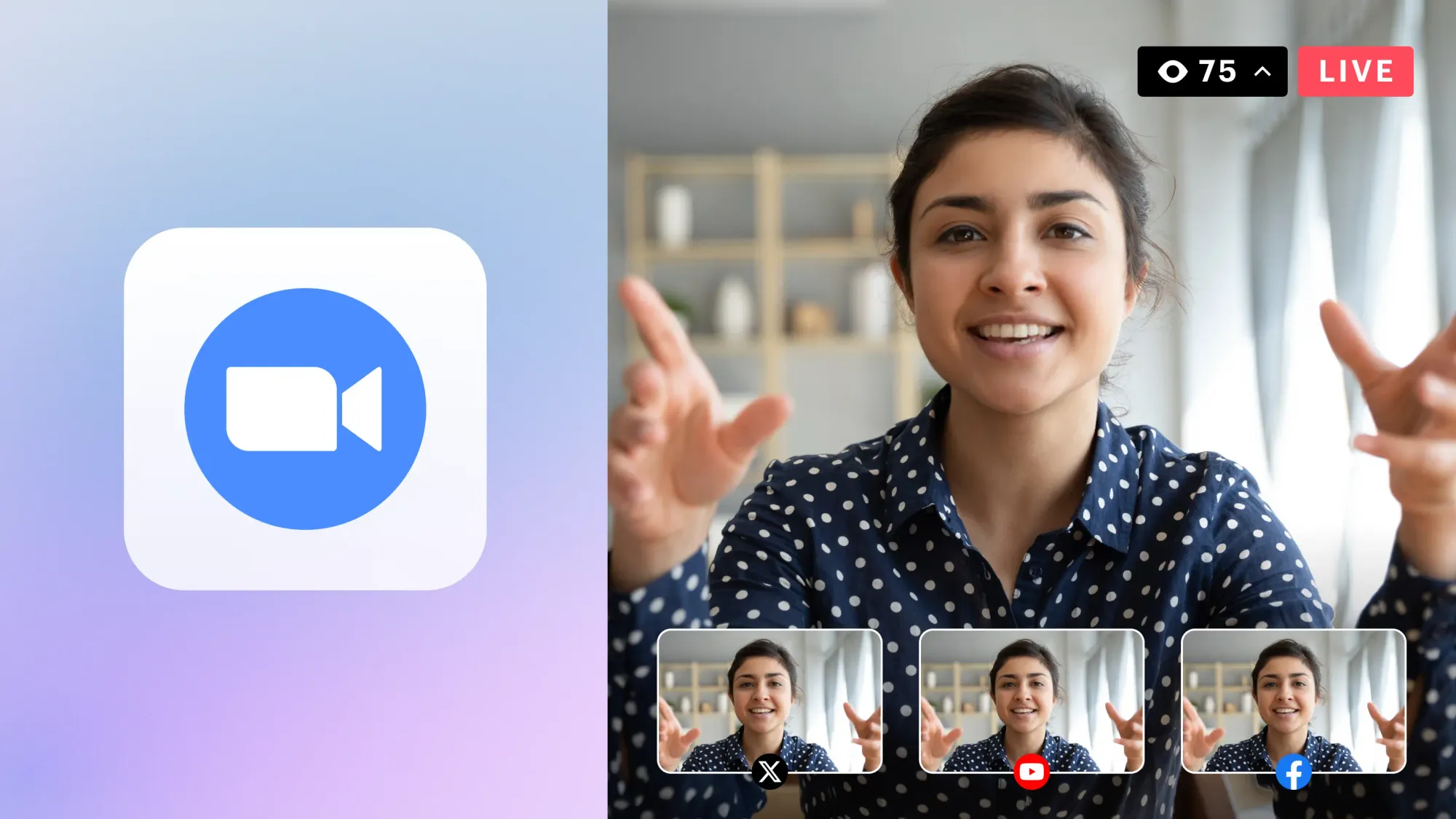An encoder is one of the key components of your live streaming setup. Without a way to encode your raw video data into a digital format for the web, you can’t go live on any platform. If you want to stream from a laptop or desktop computer — which affords you more control over your stream than broadcasting from a smartphone — you’ll need a live streaming encoder. In this guide, we cover what an encoder is, explain the difference between software and hardware encoders, and review the top 10 streaming video encoders.
What is a live streaming encoder?
An encoder takes raw video data from your camera and microphone and converts it into a digital format that you can stream on platforms like YouTube, Facebook, Twitch and LinkedIn. Usually, those digital formats are H.264, H.265, VP9 or AV1. The streaming encoder can either be a piece of software that you install on your computer or a piece of hardware that sits on your desk and connects to your computer.
Do you always need a streaming encoder to go live?
Live streaming can’t happen without encoding. If you’re not using an encoder, you might be using an app like Facebook, which lets you live stream directly from your smartphone to your Facebook profile. You don’t have to install encoding software on your phone for this process; Facebook is taking care of the encoding for you.
Is there a way to go live from a computer without downloading a software video encoder or purchasing a hardware encoder? Yes, you can use a cloud-based encoding solution like Restream Studio. Our streaming studio lets you go live straight from your browser and broadcast to multiple channels simultaneously. You don’t need any experience with streaming or encoders to get started; just create a Restream account, link your channels, and go live.
In addition to multistreaming, Restream Studio also lets you:
- Live chat with your viewers
- Add custom logos and graphics to your broadcast
- Play pre-recorded videos during the stream
- Get cross-platform insights and analytics about each stream
- Upload and stream pre-recorded video
Encoding vs. transcoding vs. codecs
You might hear the words “encoding,” “transcoding,” or “codec” thrown around when learning about live streaming. These three terms are similar but mean different things:
- Encoding: Encoding is compressing a raw video file so it can be played in a digital format. An example of an encoder is either hardware like Teradek or software like OBS Studio.
- Transcoding: Transcoding is taking an already-encoded video, decoding or decompressing it to make alterations, then re-compressing it before delivery. An example of transcoding would be lowering the video’s resolution from 1080p to 720p before it appears on the end platform.
- Codec: A codec is video compression technology short for “coder-decoder” that discards visual and audio data that doesn’t affect a video’s appearance. Examples of codecs are H.264, HVEC and VP9. Encoders use codecs to perform the encoding process.
Software encoder vs. hardware encoder
Encoders can either be software or hardware. Software encoders are programs you install on your computer that use your computer’s resources to run. Hardware encoders are external pieces of equipment that you can hook up to your computer that don’t take resources from your PC.
One isn’t better than the other; they each have benefits and drawbacks to consider. Software encoders tend to be cheaper (or free) and easier to get started with, but hardware encoders are more reliable and faster at encoding. Read our comparison guide to help you choose between a software or hardware encoder.
How to choose the best streaming encoder
When deciding which encoder to use for your live videos, keep these things in mind:
- Hardware vs. software encoder: This should be your first consideration as it will help you narrow your search.
- Compatibility with the platforms you want to stream to: Most software and hardware encoders are compatible with major streaming platforms like YouTube, Twitch and Facebook. If you want to stream on lesser-known niche sites, check that the encoder can stream to it.
- Extra features: Some useful features could be stream recording, creating scenes from multiple sources, audio mixing, 4K streaming, video effects, chroma key or remote streaming. Based on the content you’re creating, you should have an idea of which features you need.
- Budget: How much are you willing to spend on your streaming setup? If you’re just starting and want to dip your toes in, a free software encoder is best. If you’re a professional who wants to create high-quality broadcasts, you may have to invest more in your encoder.
Top 10 live streaming encoders
We reviewed the five best software encoders and five best hardware encoders to help you choose the ideal encoding solution for your live stream.
5 best software encoders
1. OBS Studio
OBS Studio is probably the best overall choice for a live streaming software encoder. It’s free, open-source, and a favorite among content creators. You can customize almost every detail of your live stream with OBS, plus it’s compatible with all major streaming platforms. Create as many scenes as you want from multiple sources and capture unlimited hours of audio and video to edit for later. The downside to OBS is that it lacks some features that paid software encoders have. Connect OBS to Restream to broadcast your stream to YouTube, Twitch, Facebook and other platforms simultaneously.
Pros
- Free
- Backed by community support
- Multiple source input options
- Easy connection to streaming platforms
- Simultaneous video streaming and recording
Cons
- Learning curve for beginning streamers
- Less-than-sleek user interface
Pricing
- Free
2. XSplit
With XSplit Broadcaster, you can mix video to capture gameplay, stream presentations, and broadcast live events. Streamers of all kinds will find something to like about XSplit, as it caters to both hobby streamers and professionals. It also has an accessible UX and tons of features that make it well worth the price, like projecting your stream on multiple screens at once, audio mixing from multiple devices, Skype Video Call integration and local network streaming. XSplit connects with Restream, so you can use it to go live on multiple platforms at once.
Pros
- User-friendly stream editing features
- Integrated green screen
- Stream delay for broadcasting at a later time
- Projector mode
- Scene preview editor
Cons
- Best features are behind the paywall
- Plug-ins cost extra
Pricing
- $15 per month
- $60 per year
- $100 for a lifetime license
3. vMix
vMix isn’t solely a live streaming encoder, but it does allow for a range of inputs such as webcams, cameras, DVDs, capture cards, playlists, presentations and photos, so you can use it to encode your live streams. The software has key features like NDI support, instant replay and slow motion, virtual streaming sets and displaying content from social media platforms. As a bonus, you can connect vMix to Restream to push your broadcast to several platforms at once.
Pros
- Supports a variety of inputs
- Wide selection of features for live streaming
- Free updates when you buy the lifetime software license
- Doesn’t use many of your PC’s resources
- Built-in audio mixer
Cons
- Compatible with Windows only
- Encoding isn’t the software’s main purpose
Pricing
You can choose from one of four lifetime software licenses for vMix:
- Basic HD: $60
- HD: $350
- 4K: $700
- Pro: $1,200
There’s also a monthly subscription for $50 per month.
4. Wirecast
Wirecast is the encoding software for video production professionals. It has powerful features and capabilities that help you produce high-quality live streams or virtual events. You get unlimited live camera inputs, screen sharing and web feed sharing, video production automation tools, live guest features and a multi-track studio. It’s also compatible with several types of capture cards and devices. If you want to live stream events, you might be better off upgrading to Wirecast Pro. Connect your Restream account to Wirecast via an RTMP link so you can use it to multistream.
Pros
- Wireless camera app to turn iOS device into a video source
- On-screen comment sharing from Facebook and X (Twitter)
- Ability to stream with multiple bitrates
- Built-in graphics tool
Cons
- Expensive
- Best features in Pro version
- Takes up a lot of memory on your computer
Pricing
- Wirecast Studio: Lifetime license for $599 or a subscription plan of $35 per month
- Wirecast Pro: Lifetime license for $799 or a subscription plan of $46 per month
5. VidBlasterX
VidBlasterX is a live streaming encoder and video production software that lets you customize everything about your stream. You can use VidBlasterX to capture, edit and broadcast your content with video effects, overlays, 4K and UHD streaming, and it has the ability to stream remotely. The user interface is based on modules and the plan you subscribe to determines how many modules you have access to.
Pros
- Fully customizable software
- Wide variety of features
- Supports multiview stream management
- Modular audio mixer
Cons
- Not for inexperienced streamers
- Incompatible with macOS
Pricing
- VidBlasterX Home: $9 per year
- VidBlasterX Studio: $99 per year
- VidBlasterX Broadcast $999 per year
5 best hardware encoders
1. Teradek
If you want to do hardware encoding for your live streams, Teradek has a wide selection of encoders to choose from. Most Teradek encoders are lightweight so you can use them for on-the-go live video content. You can go with a no-frills simple encoder like the Vidiu X, or even the Wave, Teradek’s HD encoder with a built-in monitor. If you need to bond your internet connections before pushing your broadcast live to Restream, the Vidiu Go can be purchased with attachable modems. Bonding several connections like this provides more stability and speed for your stream than using a single connection. If you’re looking for more professional encoder solutions, Teradek’s newest line, the Prism, can encode in HD or 4K HDR.
Pros
- Mobile streaming
- Compact
- Trusted brand name for encoders
Cons
- Expensive
- Not for beginners
Pricing
- Teradek encoders start at $399, with a long product line to suit all kinds of live video content producers.
2. TriCaster
TriCaster encoders come with video production systems, so they’re suitable for video professionals. The brand makes a different encoder for every type of content, from low-key portable streaming to full-scale live events. TriCaster products have HD-SDI inputs and are compatible with a wide range of hardware and accessories. They also offer real-time encoding and live streaming recording capabilities. Depending on which model you choose, you could have 4K and UHD streaming, a 7-band audio equalizer, customizable thumbnails or data presets.
Pros
- Processes moving graphics in real time
- Auto-archives videos for on-demand playback
- Editing tools and features for audio and video
Cons
- Pricey
- Bulky hardware
Pricing
- TriCaster encoders range from $5,000 to $18,000, depending on the retailer you purchase from.
3. Niagara Video
Some of the world’s largest brands trust Niagara Video’s encoders and for good reason. They offer a wide range of encoder options and have been at the forefront of the live streaming industry for decades. With so many different encoders to choose from, there are choices for education streamers, church live streams, public events and more. Depending on the model, a Niagara Video encoder may have an integrated solid-state drive, a web SDK for customizations, HD-SDI inputs and MP4 video file recording.
Pros
- Several types of encoders with different features
- Support for encoding and transcoding
- Equipment for enterprises
Cons
- Almost too much power for smaller productions
- Prices aren’t available online
Pricing
- Niagara Video doesn’t disclose the prices for their products on the website. You have to contact them for pricing.
4. Blackmagic Design ATEM Mini Pro
Blackmagic Design makes a range of products for live streaming and video production, and the ATEM Mini Pro is perfect for streams with a multi-camera setup. It’s a video switcher with a streaming encoder built-in, so you can have four video inputs and switch between them during your broadcast with the same device. It’s also portable and sleek and streams in 1080p.
Pros
- Switcher with built-in encoder
- Portable for on-the-go streaming
- Control panel for stream management
Cons
- A bit expensive
- Not quite user-friendly for new streamers
Pricing
- $495 (may vary depending on the retailer)
5. URayCoder
URayCoder Wired 1080p H.264 HDMI by URayTech is a good option if you want the power of a hardware encoder without a large price tag. It has an HDMI loop-through feature, so you can hook up a monitor directly to the encoder to watch the video locally. It also comes with automatic frame rate detection and video enhancement adjustments. It’s a decent encoder that will get the job done for smaller productions, and a good foray into hardware encoding thanks to the lower price.
Pros
- Saves on bandwidth
- Less pricey than competitors
- Supports a wide variety of formats
Cons
- Less reliable encoding
- Upgrade to more expensive model required for SDI input
Pricing
- $150-$200
Use Restream with encoding software to multistream
One of the best ways to reach a bigger audience is by multistreaming, or broadcasting your live stream to multiple platforms at once. When you combine encoding software with Restream, you can easily go live on several platforms, thanks to the following features:
- Restream supports over 30 top streaming platforms from large global streaming sites to regional and niche ones.
- It takes two minutes to set up; all you need is a Restream account and the intuitive interface makes adding channels a breeze.
- Restream works with most major encoding software and probably integrates with a streaming platform if your encoder doesn’t have native support for it.
- You can try multistreaming for free by signing up for our Basic plan.
Restream operates on any computer, PC or Mac, and you don’t need to purchase any additional software or hardware to use it.
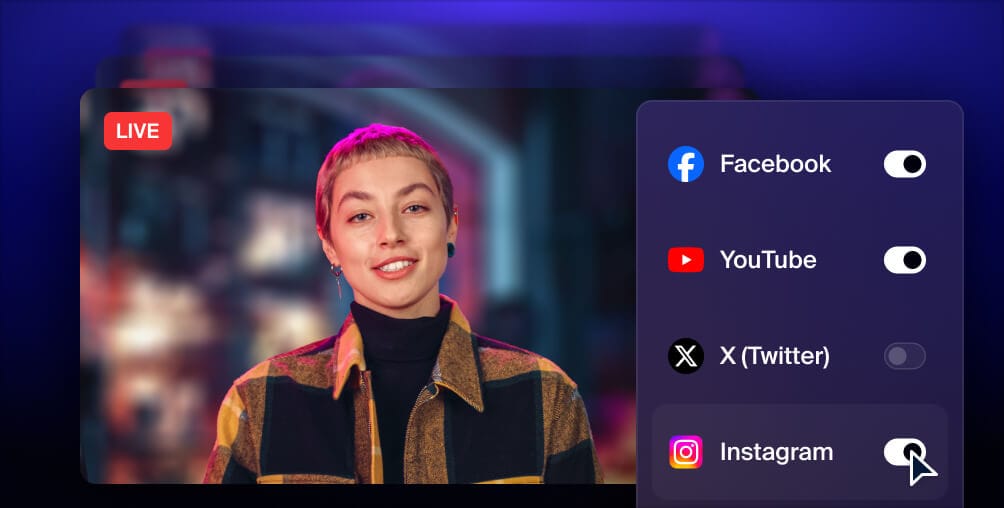
Get more views with multistreaming
Reach more people, and meet viewers where they like to watch. Live stream to YouTube, Instagram, Facebook, Twitch, X, TikTok, LinkedIn, and more at once.
All it takes is connecting your Restream account to your favorite streaming channels like YouTube, Twitch or Facebook, and then connecting Restream to your encoding software. Read our platform guides to get started:
FAQs
What is a streaming encoder?
A video streaming encoder converts your video into digital format so that it can be broadcasted online. If you want to live stream on platforms like Twitch, YouTube, Facebook and Instagram, you’ll need to encode your video. You can use a software video encoder or a hardware video encoder.
Do I always need a streaming encoder to go live?
You need a streaming video encoder to broadcast live video on the internet. However, some apps like Facebook and Instagram allow you to go live directly from their mobile application, meaning you don’t need a separate encoder as the app handles the video encoding for you.
What is a hardware encoder?
A hardware encoder is a device that encodes video and makes it able to be transmitted over the internet. When compared to software encoders, hardware encoders generally tend to be more reliable, but also more expensive.
Which 4K streaming encoder should I choose?
The best 4K software video encoders are vMix and VidBlasterX. The best 4K hardware video encoders are the Teradek Prism and the TriCaster Mini 4K.
Conclusion
Live streaming with an encoder isn’t some big mystery — and it’s definitely not hard to do. If you choose the right encoder for your content, you can produce a high-quality stream that engages your viewers. And if you use Restream to multistream, you can expand your audience to multiple streaming platforms.



